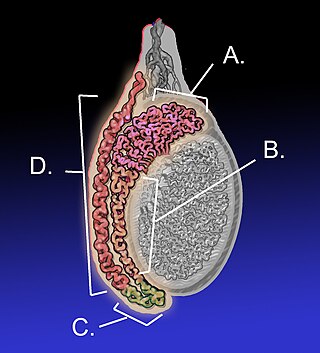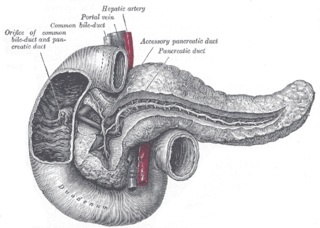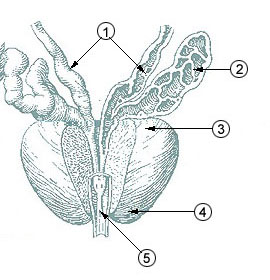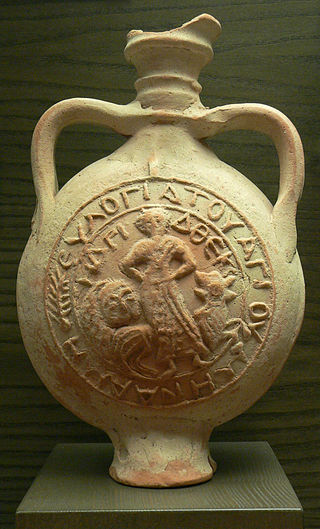
A bile duct is any of a number of long tube-like structures that carry bile, and is present in most vertebrates.

The semicircular canals or semicircular ducts are three semicircular, interconnected tubes located in the innermost part of each ear, the inner ear. The three canals are the horizontal, superior and posterior semicircular canals.

The seminal vesicles are a pair of two convoluted tubular glands that lie behind the urinary bladder of some male mammals. They secrete fluid that partly composes the semen.
The water vascular system is a hydraulic system used by echinoderms, such as sea stars and sea urchins, for locomotion, food and waste transportation, and respiration. The system is composed of canals connecting numerous tube feet. Echinoderms move by alternately contracting muscles that force water into the tube feet, causing them to extend and push against the ground, then relaxing to allow the feet to retract.

The epididymis is a tube that connects a testicle to a vas deferens in the male reproductive system. It is a single, narrow, tightly coiled tube in adult humans, 6 to 7 meters in length. It serves as an interconnection between the multiple efferent ducts at the rear of a testicle (proximally), and the vas deferens (distally).

The vas deferens, with the more modern name ductus deferens, is part of the male reproductive system of many vertebrates. The ducts transport sperm from the epididymis to the ejaculatory ducts in anticipation of ejaculation. The vas deferens is a partially coiled tube which exits the abdominal cavity through the inguinal canal.

The spermatic cord is the cord-like structure in males formed by the vas deferens and surrounding tissue that runs from the deep inguinal ring down to each testicle. Its serosal covering, the tunica vaginalis, is an extension of the peritoneum that passes through the transversalis fascia. Each testicle develops in the lower thoracic and upper lumbar region and migrates into the scrotum. During its descent it carries along with it the vas deferens, its vessels, nerves etc. There is one on each side.

The inguinal canals are the two passages in the anterior abdominal wall of humans and animals which in males convey the spermatic cords and in females the round ligament of the uterus. The inguinal canals are larger and more prominent in males. There is one inguinal canal on each side of the midline.

The human reproductive system includes the male reproductive system which functions to produce and deposit sperm; and the female reproductive system which functions to produce egg cells, and to protect and nourish the fetus until birth. Humans have a high level of sexual differentiation. In addition to differences in nearly every reproductive organ, there are numerous differences in typical secondary sex characteristics.

The pancreatic duct, or duct of Wirsung, is a duct joining the pancreas to the common bile duct. This supplies it with pancreatic juice from the exocrine pancreas, which aids in digestion.

The vestibular nerve is one of the two branches of the vestibulocochlear nerve. In humans the vestibular nerve transmits sensory information transmitted by vestibular hair cells located in the two otolith organs and the three semicircular canals via the vestibular ganglion of Scarpa. Information from the otolith organs reflects gravity and linear accelerations of the head. Information from the semicircular canals reflects rotational movement of the head. Both are necessary for the sensation of body position and gaze stability in relation to a moving environment.

The testicular artery is a branch of the abdominal aorta that supplies blood to the testis. It is a paired artery, with one for each of the testes.

The prostatic urethra, the widest and most dilatable part of the urethra canal, is about 3 cm long.

The ampulla of vas deferens, also called the ampulla of ductus deferens, is an enlargement of the vas deferens at the fundus of the bladder which acts as a reservoir for sperm. This structure is seen in some mammalian and squamate species and is sometimes tortuous in shape.
Ductuli aberrantes are two long narrow tubes, the ductulus aberrans inferior and the ductulus aberrans superior. The ductulus aberrant inferior, is occasionally found connected with the lower part of the canal of the epididymis, or with the commencement of the vas deferens.

The Holy Ampulla or Holy Ampoule was a glass vial which, from its first recorded use by Pope Innocent II for the anointing of Louis VII in 1131 to the coronation of Louis XVI in 1774, held the chrism or anointing oil for the coronation of the kings of France.

The reproductive system of gastropods varies greatly from one group to another within this very large and diverse taxonomic class of animals. Their reproductive strategies also vary greatly, see Mating of gastropods.

The fallopian tubes, also known as uterine tubes, oviducts or salpinges, are paired tubes in the human female that stretch from the uterus to the ovaries. The fallopian tubes are part of the female reproductive system. In other mammals they are only called oviducts.

An ampulla was, in Ancient Rome, a small round vessel, usually made of glass and with two handles, used for sacred purposes. The word is used of these in archaeology, and of later flasks, often handle-less and much flatter, for holy water or holy oil in the Middle Ages, often bought as souvenirs of pilgrimages, such as the metal Monza ampullae of the 6th century. Materials include glass, ceramics and metal. Unguentarium is a term for a bottle believed to have been used to store perfume, and there is considerable overlap between the two terms, one defined by shape and the other by purpose.